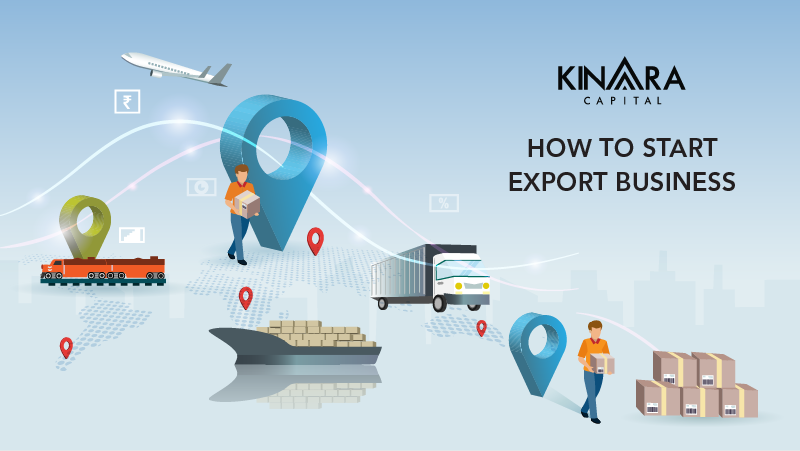India is on the path to massive growth as an economy, taking up centre stage in the global economy as a market and an exporter. New international markets are opening up to local sellers who can offer the right products to match global demand. Global supply chains are becoming systematically interlinked, and businesses are digitizing their production as well as distribution. This has significantly increased the ease of doing business overseas and motivated many domestic manufacturers to export their products to foreign markets.
While exporting is not a new concept, for a new business owner, starting an export business could be daunting. Even though several government initiatives support MSME exports, the perceived complexity of the process keeps many businesses limited to the domestic market. Read on to find out how to start export business as an MSME, the prerequisites, and the considerations for becoming a successful exporter.
Who Can Become an Exporter?
Any MSMEs can start exporting its products, given there is demand and they meet certain criteria. Exporters can explore new markets, grow their net profitability, and improve product quality when they start exporting. Under the Foreign Trade Policy (FTP), any person or registered business entity can become an exporter, provided they satisfy the given prerequisites defined by the government. For MSMEs, these requirements include:
- Business registration: MSMEs registered as a sole proprietorship, partnership business, limited liability company, or company are eligible to export.
- Business bank account: Although every MSME already has a linked business account for export purposes, it is best to have a current account with a bank authorised to deal with foreign exchange.
- Linked PAN: The MSME owner’s PAN (Permanent Account Number) must be linked to the business before starting an export business.
- Import Export Code (IEC) Number: An IEC is a unique, 10-digit, alpha-numeric code that is issued on the basis of the MSME’s PAN number. As per the FTP, it is mandatory to have an IEC number for conducting any import-export business.
Grow your MSME with collateral-free business loans
How to Start Import Export Business
Today, close to 50% of the national exports are contributed by MSMEs. This is indicative of the fact that many MSME business owners have realized the incredible benefits of exporting. If your’re wondering how to start import export business, read on. Here’s how to start export business as an MSME:
- Obtaining an IEC: To obtain an IEC, you need to file an online application at www.dgft.gov.in and pay a fee of Rs. 500. Along with your application, you have to submit a valid digital signature token (Class II or III), copies of your PAN card and Aadhar card, your mobile number, email ID, address, and bank account details.
- Selecting Products for Exporting: While your IEC application is getting processed, you need to select the product(s) that you plan to start exporting. For MSMEs with multiple product lines, this means carefully analyzing each product and its export potential. You also need to ensure that your selected products are freely exportable and not covered in prohibited or restricted lists.
- Selecting Target Market(s): Next, you need to select your products’ most viable target market. You can research multiple countries and compare them in terms of market size, competition, product quality requirements, payment terms, and special export benefits. Export promotion councils (EPCs) and Indian Missions abroad can help in gathering the required information.
- Finding Buyers: If you’re wondering how to start import-export business from home, the first step is to find buyers. Participate in trade fairs, buyer-seller meets, and exhibitions to find potential buyers. B2B portals, EPCs, Indian Missions abroad, and overseas Chambers of Commerce can also help you.
- Website and Sampling: To attract importers to your business, you can also start an import-export business from home and set up a multilingual website and geo-target it to countries where you wish to export. In addition, you can invest in providing customized samples to prospective customers for getting export orders. This is allowed without any limit for freely exportable items under the FTP 2015-2020.
- Setting the Right Price: To export profitably and grow your customer base, your price should be competitive yet give you the best possible profit margin. Prepare an export costing sheet for all the products to be exported and then work out the pricing. Take into consideration necessary expenses like sampling, cost of production, insurance and freight (CIF), Cost and Freight (C&F), and Free on Board (FOB) terms.
- Negotiating the Terms: Even if you are new to exporting, you are well within your rights to negotiate the terms of trade. Evaluate every buyer in terms of buying ability and prospects. You can also demand Letters of Credit (LOC) or advance payment while booking an order.
- Covering Your Risk Through ECGC: If a buyer can provide neither LOC nor advance payment, you can protect your interest by covering the risk of payment default through ECGC (Export Credit Guarantee Corporation Limited). The ECGC provides a credit limit on the foreign buyer and protects your financial interests in case of contingencies.
You must also explore various initiatives started by the Government of India to promote MSME exports. These include IGST refund, tax-free export under LUT bond, and concessional rates for merchant exporters. The government also offers ‘Status Holder Certificates’ star ratings and quality awards for exporters, which can elevate your brand profile. There are also interest equalization schemes, transport and marketing assistance, market exploration support, and production-linked incentives for MSME exporters.
Find a Growth Partner for Your Exporting Journey
Now that you understand the basics of how to start import export business, it is time to start planning your venture. Starting an export business may be a vast concept and can take a lot of preparation. But with a structured approach and careful consideration of all internal and external factors, MSMEs can successfully start an import-export business from home. In addition to various export-promoting initiatives by the government, banking and financial institutions also provide financial assistance to aspiring exporters.
While banks can provide loans against LOCs, financial service providers like Kinara Capital offer specialized working capital loans to MSMEs for fulfilling export orders. MSMEs can also avail loans for purchasing assets from Kinara Capital to expand their production capacities and meet the growing export demand. So, all you need to do is start an import-export business from home and get started on your exporting journey.
Check your Eligibility in 1-minute!

